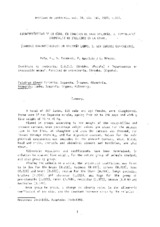Mostrar el registro sencillo del ítem
Características de la canal en corderos de raza segureña. I. Componentes corporales no incluídos en la canal
| dc.contributor.author | Domenech García, V. | es_ES |
| dc.contributor.author | Peña Blanco, Francisco | es_ES |
| dc.contributor.author | Méndez Medina, D. | es_ES |
| dc.contributor.author | Aparicio Ruiz, F. | es_ES |
| dc.date.accessioned | 2010-05-12T17:04:48Z | |
| dc.date.available | 2010-05-12T17:04:48Z | |
| dc.date.issued | 1989 | |
| dc.identifier.issn | 1885-4494 | |
| dc.identifier.uri | http://hdl.handle.net/10396/3259 | |
| dc.description.abstract | A total of 347 lambs, 198 male and 149 female, were slaughtered. These were if the Segureña strain, ageing from 60 to 150 days and with a live weight of 16 to 40 Kg. Placed in groups according to the weight of he newly-killed and dressed carcass, mean percentage weight values are shown for the animals live in the flod, at slaughter and when the carcass was dressed, for losses through starving, and for digestive content. Values for the main phisical componentes not included in the dressed carcass, skin, blood, head and brain, thoracic and abdominal viscera and testicles, are also shown. Allometric equations and coefficients have been determined, in relation to starved live weight, for the entire group of animals studied, and also group by group. Viewing the animals as a whole, the allometric coefficient was found to be low for the brain (0.261), kidneys (0.612), spleen (0.763), head (0.826) and heart (0.892), medium for the liver (0.966), lungs including trachea (1.051), and abomasum (1.055), and high for the group of pre-stomachs (1.222), rumen (1.240), reticulum (1.370), omasum (1.616) and testicles (3.370). From group to group, a change is clearly noted in the allometric coefficient of the skin, and the constan increase shown by the relative growth of the spleen, kidneys and testicles should also be noted. | en |
| dc.description.abstract | Se sacrifican un total de 347 corderos, 198 machos y 149 hembras, de raza segureña, con edades y peso vivo comprendidos entre 60 y 150 días y 16 y 40 kg, respectivamente. Agrupados en lotes, por intervalos de peso canal caliente, se obtienen, para cada uno de ellos, los valores medios y porcentajes del peso vivo aprisco, sacrificio y vacío, pérdidas por ayuno y contenido digestivo. Así como los correspondientes a los principales componentes corporales no incluidos en la canal: piel, sangre, cabeza y cerebro, vísceras torácicas y abdominales y testículos. Así mismo, se determinan las rectas y coeficientes alométricos para dichos componentes, en el total de la población y por sexos, en el conjunto del período estudiado y entre lotes. Respecto del peso vivo vacío se comprueba el lento ritmo de crecimiento relativo del cerebro (b = 0,261), riñón (b = 0,763), cabeza (b = 0,826) y corazón (b = 0,892), isométrico en el hígado (b = 0,966), pulmón + tráquea (b = 1,051) y abomaso (b = 1,055), y el tardío para el relativo del conjunto de pre-estómagos (b = 1,222), rumen (b = 1,240), retículo (b = 1,370), omaso (b = 1,616) y testículos (b = 3,370). De igual forma, destaca el cambio, entre lotes, en el coeficiente de alometría de la piel y la continua aceleración que, en su crecimiento relativo, muestran el bazo, sangre, riñones y testículos. | es_ES |
| dc.format.mimetype | application/pdf | es_ES |
| dc.language.iso | spa | es_ES |
| dc.publisher | Universidad de Córdoba, Servicio de Publicaciones | es_ES |
| dc.rights | https://creativecommons.org/licenses/by-nc-nd/4.0/ | es_ES |
| dc.source | Archivos de zootecnia 38 (141), 107-125 (1989) | es_ES |
| dc.subject | Canal | es_ES |
| dc.subject | Alometría | es_ES |
| dc.subject | Segureña | es_ES |
| dc.subject | Corderos | es_ES |
| dc.title | Características de la canal en corderos de raza segureña. I. Componentes corporales no incluídos en la canal | es_ES |
| dc.title.alternative | Carcass characteristics in segureña lambs. I. Non-carcass components | en |
| dc.type | info:eu-repo/semantics/article | es_ES |
| dc.relation.publisherversion | http://www.uco.es/organiza/servicios/publica/az/az.htm | es_ES |
| dc.rights.accessRights | info:eu-repo/semantics/openAccess | es_ES |

